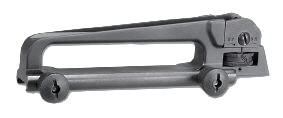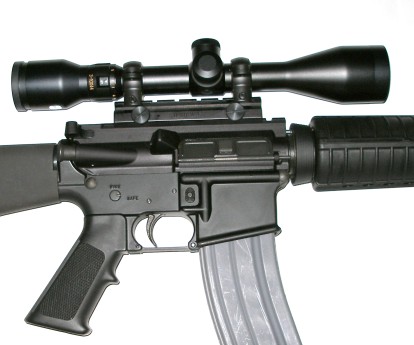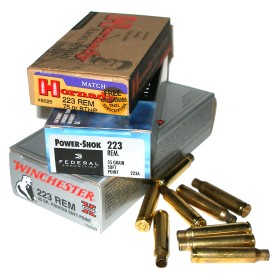
Fall in Maine is a great time to be outdoors. The air is cool, but still not really cold, and the leaves have turned color, but cover is still heavy. I was in a small clearing, shooting from the prone position at a target roughly 100 yards out, building experience with an AR15 type rifle. It was great fun; the sharp crack of the small caliber cartridge, the thumping of the semi-auto action cycling in my hands and the stream of empty cases being tossed on the ground beside me. While I found it easy to understand how shooters become very attached to these firearms, I admit I was surprised to find the little rifle so intuitive to shoot.
I ignored AR type firearms for a very long time. Devoid of walnut and blued carbon steel, they seemed more appropriate for military, law enforcement or serious security work. With my personal experience limited to less than accurate and less than flexible Remington and Browning autoloaders, and ancient military pieces, ARs appeared to feed a shooter’s overactive imagination more than serve a useful purpose as a sporting rifle. When we moved Real Guns to Maine, and I found I had many more options when it came to firearm ownership, I decided I needed to at least investigate and develop a better understanding of these rifles. Ever the technical geek, and less the consummate hunter, I finally arrived at the same conclusion as maybe 10 or 15 billion others before me; the AR is a pretty spiffy firearm with a deceptively simple design.
Great, Joe, now can you single one out?
For the sake of simplicity, and a bold display of my distain for minutia, I am occasionally going to use the term AR15 as a description of a generic type of firearm. The AR15 represents the foundation for an incredible number of accessory building blocks, blocks that can be assembled into a virtually unlimited number of final firearm configurations. There are stocks and grips, barrels and rails, floating and fixed handguards, and trigger assemblies of multiple designs. There are flat top guns and carry handle guns, a myriad of sight types and sight systems, plus heavy weight, ultra light weight and everything in between weight barrels. Receivers are made of aluminum, carbon fiber, poly and titanium in the mainstream; some forged, some cast and some billet. Guns can be purchased whole and slick with all the bells and whistles from companies like: Armalite, Bushmaster, DPMS, Fulton Armory, High Standard, Olympic, Rock River, Stag Arms, and Wilson Combat. Some of these companies manufacture, some outsource and some pick components from a variety of sources and assemble the parts into finished firearms. There are even hybrid designs that stray from MIL Spec to accomplish very specific performance goals, like the proprietary action guns manufactured by JP Enterprises or Stag Arms guns for lefties. For the overachievers, with time on their hands and a machine shop in their garage, there are kits of rough forging awaiting finesse by a competent machinist to bring them to life as a functioning firearm.
Chambers and cartridges vary greatly. The original round for the AR15 is the 5.56x45mm NATO, a close cousin to the .223 Remington, but with slightly higher operating pressure and intended for use in a chamber with a slightly longer throat. I got my first clue regarding longer throat length requirements when I shot some old Winchester USA 5.56x45mm ammo in my Model 7 .223 Remington with interesting, eyebrow raising results. I finally sorted it out with SAAMI cartridge spec sheets and chamber drawings. A MIL Spec gun will typically have a 5.56x45mm spec chamber, but some have a .223 SAAMI standard chamber and some a modified SAAMI chamber with longer throats that permit the use of very heavy, let’s call that very long, .224″ bullets. This brings us to another variable, rifling. Where a Remington sporting rifle with a .223 chamber might have a 12″ twist, typically 9″ is used in current MIL Spec guns, 8″ in guns slated for heavy bullet and 7″ those ultra long competition bullets.
There is no shortage of alternative cartridge selections for the AR15 shooter. Just about anything 2.260″ in length can be pushed through this extremely adaptable rifle. There are cartridges like the 6.5 Grendel, the 7.62x39mm Russian, the 45 Bushmaster and 458 SOCOM, the 50 Beowulf, the WSSM series, and even the .204 Ruger and .17 Remington varmint rounds. Essentially an AR15 owner can be covered for hunting anything from field mice to bear, and just about everything in between. A good basic gun with an assortment of uppers or barrels can be extremely flexible in purpose.
Stripped or fully loaded?
The world of AR15s is filled with interesting facts, conflicting theories, folklore, clichés, and some pretty silly terminology. I came away from early research with the considered opinion that a Bushmaster is a Bushmaster and no grown man should ever refer to anything he owns as a “Bushy”, or put a “y” or “ie” at the end of hardly any word in their public vocabulary. I further came to the early conclusion that some of the accessories found on high dollar ARs fully loaded models may address AR design problems that are more folklore than fact. As an old time auto racer of less than remarkable achievement, I know there is no limit to the amount of crap a racer would buy in an attempt to cover up his lousy driving and general lack of talent. Think about that relationship when the guy next to you at the range, with the $3,000 custom, can’t get on the paper at 100 yards. What I needed was a very standard rifle I could use to baseline and test all of these AR15 performance axioms. I could then go on and work my way through all of the popular accessories and modifications, measuring the resulting improvement, or lack of the same. Selecting a gun of high quality would be important as I would need to be assured I was testing performance inherent to design and not manufacturing capability.
After examining many brands and models, and after making lots of research phone calls to these companies, I selected a High Standard HSA15, more specifically a HSTX6550, a MIL Spec compliant 20″ barrel flat top. The HSA15 series is produced by High Standard Manufacturing, a company operating under the Crusader Gun Group of Houston, TX. A serious firearms group, the company produces everything from fully automatic Class III weapons for military contract, to High Standard target pistols and a recently resuscitated AMT handgun product line. The HSA15 models are available in 4 configurations; carry handle and flat top, both in 16″ carbine and 20″ rifle barrel versions.

| HSTX6550 | As Received |
| Overall Length | 39 1/2″ |
| Length of Pull | 13 1/2″ |
| Weight Empty | 8 lbs |
| Weight With Scope | 9 1/2 lbs |
| Front Sight | Elev Adj Post |
| Rear Sight | None |
| Barrel Length | 20″ |
| Twist Rate | 1:9″ RH |
| Trigger Pull | 8 1/2 lbs |
| Magazine | 30 Rounds |
| MSRP | $920 |
| Typical | $780 |
As received, the HSTX6550 gives the appearance of a firearm typically shipped in quantity to a military, law enforcement or security agency where they would be outfitted with appropriate accessories prior to being issued to personnel. The HSTX6550 flat top 20″ barrel model comes with one 30 round magazine, no rear sight, a post front sight and a several page, staple bound, black and white manual. The shipping carton is plain brown cardboard, oddly enough with no insert to hold the rifle in place during transit. This is something I wish High Standard would correct as the rifle inside is a gem and deserves the extra care. Clean, slick and smooth in function, the fit and finish of forgings and synthetic parts rival many expensive sporting rifles and some of the most expensive AR15 fixtures on the market. High Standard utilizes a satin black hard coat anodized finish on the forged aluminum receiver and matte black Mil Spec Parkerized finish on all steel parts; tough, durable and not inexpensive finishing. Laying the High Standard down next to a Bushmaster Predator that sells for $400 more, over 40% more, made me even more sure of my decision; the High Standard quality inside and out was every bit s good as, or better than the Bushmaster and the accessory differences in no way justifies the cost difference.
Prepping for Shooting

The flat top High Standard come with a standard front post sight, but lacks a rear sight as the flat top is generally a configuration for optical sights of some sort. Lots of accessory manufacturers offer an A3 type detachable carry handle for use with the standard front sight. I opted not to buy one of these for a few reasons. The first reason, cost; these gems run about $110-$140. The second reason is that the standard A2 sight set up does not represent the best mechanical sight available. The third reason is that I hate open sights and I did not want to perpetuate their presence on a rifle that would be wearing a scope. Yes, I do have a project planned to assess metallic and optical sights, but this was not in the cards for a first outing.

I virtually have no neck, the HSA15 has no drop at the heel of its stock, which you might think makes us even; it does not. If I did not want to shoot through sights perched atop an accessory handle A3 mount, I needed to do something else or relocate my eyes just south of my chin.
I installed a $45 B-Square 1″ riser that converts from Picatinny to a Weaver style base, then I installed $32 Burris Zee Signature rings with synthetic pivoting inserts. The set up is quick detach without losing zero, the combo of base and rings nearly clear the a scope’s optical center above the front sight and the inserts grab on and come into alignment with the scope tube as hey are tightened down. Most important, the set up falls into natural alignment with my eye when in a shooting stance and looking through a Mueller 3-10×44 Tac II Mildot scope. This is pure conjecture, but I have heard the absence of an integral carry handle makes for a less rigid receiver on these models. At some point in time I will stress the upper receiver and measure the deflection. For now, I would assume the B-Square riser could make the upper receiver assembly more rigid.
With ammo it’s even better

The High Standard barrel has a 9″ twist. To put this in perspective, the Bushmaster which is billed as optimized for .224″ bullets in the upper weight range, has an 8″ twist. 9″ is generally considered an all purpose rate, 8″ is more for above 69 grain match bullets. For test purposes I selected ammunition from a number of manufacturers in a variety of bullet weights and types. All together I worked my way through a 300 round single session.
From the standpoint of reliability, the HSA15 ate everything it was fed without mishap in feed or ejection, even when ammo types were mixed in the same 30 round magazine and velocity varied greatly from one ammo type to another. I shot close interval 3 shot groups without negative influence from temperature or fouling. Nothing shot loose, nothing fell off.
| Ammunition | Bullet Grains |
Bullet Type |
Average FPS |
100 Yard 3 Shot Group |
| Federal Power Shok | 55 | Soft Point | 3046 | 1″ |
| Hornady Match | 75 | BTHP | 2647 | 1/2″ |
| Remington Premier Match | 62 | HP | 2817 | 3/4″ |
| Remington Express | 55 | Soft Point | 3080 | 1 1/4″ |
| Winchester USA | 62 | FMJ | 2861 | 1 1/2″ |
| Winchester Super-X | 55 | Soft Point | 3135 | 1″ |
| Black Hills | 60 | V-Max | 2994 | 1″ |
 Examples of the best and worst. I shot groups from the prone position with the underside of the barrel resting on a shooting box. Based on the inaccuracy typically attributed to sling/non-floating handguard barrel loading comments I’ve seen as justification for switching to a floating guard, I thought the gun would shoot all over the place; Of course it did not. In fact I assume the gun is capable of more than my shooting skills could deliver. I had fun shooting offhand 100 yard groups, although this is not typically something I do when shooting for accuracy. I could shoot 4″ – 6″ without much trouble, if I cranked up the scope and took my time to work through a way too stiff trigger. Yes, I know, practice.
Examples of the best and worst. I shot groups from the prone position with the underside of the barrel resting on a shooting box. Based on the inaccuracy typically attributed to sling/non-floating handguard barrel loading comments I’ve seen as justification for switching to a floating guard, I thought the gun would shoot all over the place; Of course it did not. In fact I assume the gun is capable of more than my shooting skills could deliver. I had fun shooting offhand 100 yard groups, although this is not typically something I do when shooting for accuracy. I could shoot 4″ – 6″ without much trouble, if I cranked up the scope and took my time to work through a way too stiff trigger. Yes, I know, practice.
Comments worth making
It would be hard to not like this gun, most negative aspects are more related to the AR15 design than the High Standard product. Shooting offhand with a 30 round clip in place can lead to scoliosis and it takes talent to grab the charging bar from beneath a large ocular lens scope. The rifle is heavier than it looks and most of the mass is right at the receiver, but then the receiver has to support the barrel, so I don’t think the gun could be much lighter and still shoot straight. By the same token, a number of the nice features are design related and not so much brand related; all of the controls are almost perfectly placed, operation is crisp and positive and the gun points like an obedient finger. The trigger pull I will lay on High Standard. If there is an ailment called carpal tunnel finger, I now have it. I may have to do finger push ups before embarking on another episode at the range. Still, it wasn’t like the trigger didn’t have feel and it certainly wasn’t mushy. The trigger broke like glass, very, very thick glass.

Again, I am amazed at how cleanly the gun was forged, machined and stamped. I couldn’t find a rough edge or scratched surface anywhere and I am really picky. The gun cleaned up really well after shooting, even the brass deposits that accumulated on the boss immediately behind the ejection port wiped off with a cloth dipped in solvent. I used the term MIL Spec a number of time throughout this article, and I know someone will raise the issue that if it isn’t an M16 it can’t be MIL Spec. High Standard Manufacturing produces M16s and the common and/or equivalent part types used for both guns are of a common dimension; standard accessories will fit this firearm. As an example, the B-Square base I used is listed for a Colt firearm and I was able to plop on a 50 Beowulf upper without any problem, but I’ll save those details for another story. Look for more projects based on this gun, I know we’re looking forward to them.
Thanks
Joe
Comments appearing below are posted by individuals in a free exchange, not associated with Real Guns. Therefore RGI Media takes no responsibility for information appearing in the comments section. Reader judgement is essential.

Email Notification